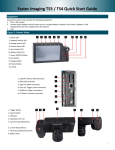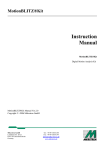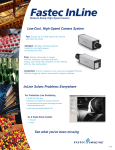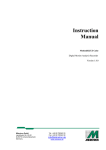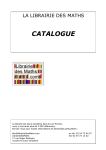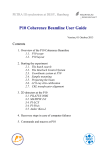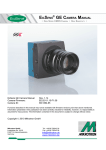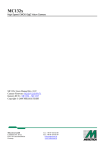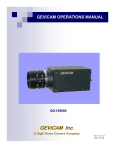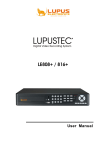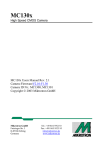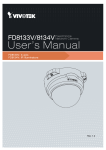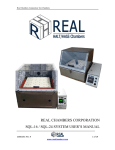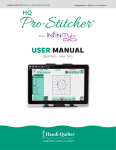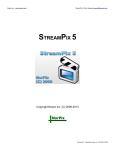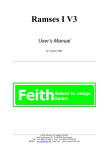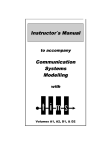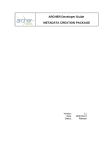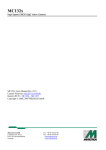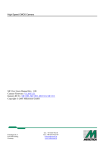Download "user manual"
Transcript
Operator’s Manual HiSpec 1 & 2 Cameras HiSpec 4 & 5 Cameras Director 2 Software Digital Motion Analysis Recorders Version 1.1.0 Fastec Imaging Corp. 17150 Via Del Campo Ste. 301 San Diego, CA 92127 USA Tel.: +1-858-592-2342 Fax: +1-858-592-2342 [email protected] www.fastecimaging.com 1 GENERAL ........................................................................................................ 6 1.1 ESSENTIALS OF HISPEC EOSENS CUBE / MINI CAMERAS ............................................. 6 1.2 CUSTOMER INDICATIONS .................................................................................. 6 1.2.1 For customers in the U.S.A. ....................................................................... 6 1.2.2 For customers in Canada ........................................................................... 7 1.2.3 Pour utilisateurs au Canada ....................................................................... 7 1.2.4 Life Support Applications ........................................................................... 7 1.3 DECLARATION OF CONFORMITY ........................................................................... 7 1.4 WARRANTY NOTE .......................................................................................... 8 1.5 REMARKS, WARNINGS..................................................................................... 8 1.6 SIDE AND BACKSIDE VIEWS OF HISPEC CAMERAS ...................................................... 9 1.6.1 The rear of the camera ............................................................................. 9 1.6.1.1 EoSens Cube ................................................................................................... 1.6.1.2 EoSens mini ................................................................................................... 1.6.2 The right side of the camera, EoSens Cube ................................................ 10 1.6.2.1 Connectors................................................................................................... 10 1.6.2.2 Switches ...................................................................................................... 10 1.6.2.3 LEDs ........................................................................................................... 11 1.6.2.3.1 Upper LED: battery charging and power indication...................................... 11 1.6.2.3.2 Lower LED: internal camera state............................................................ 13 1.6.3 The front of the camera .......................................................................... 13 1.7 SCOPE OF DELIVERY ..................................................................................... 14 1.8 HISPEC VERSIONS:...................................................................................... 15 1.9 POWER SUPPLY AND CHARGING ......................................................................... 17 1.9.1 Battery charging .................................................................................... 17 2 OPERATING MODES ...................................................................................... 18 2.1 STANDBY (FOR 2 AND HISPEC 2-HR CAMERAS ONLY) .............................................. 18 2.2 READY-TO-OPERATE ..................................................................................... 19 2.2.1 Live mode ............................................................................................. 20 2.2.2 Prepare for recording .............................................................................. 20 2.2.3 Start recording ...................................................................................... 21 2.2.3.1 Recording modes .......................................................................................... 21 2.2.3.1.1 Single mode (non circular) ...................................................................... 21 2.2.3.1.2 Ring mode (circular recording)................................................................. 21 3 INSTALLATION OF HISPEC ........................................................................... 22 3.1 MINIMAL SYSTEM REQUIREMENTS (PC) ............................................................... 22 3.2 INSTALLATION OF THE SOFTWARE ...................................................................... 23 3.2.1 Installation of the EBus driver .................................................................. 23 3.2.2 Assigning an IP-address to the GigaBit Ethernet adapter .............................. 24 3.3 CONNECTING THE HISPEC TO THE PC AND STARTING PROGRAM ................................... 26 3.3.1 Camera name ........................................................................................ 27 3.3.2 Multi camera operation ........................................................................... 28 3.3.2.1 Synchronizing cameras .................................................................................. 28 3.4 3.5 4 RECOMMENDED NETWORK ADAPTERS .................................................................. 28 NETWORK-CONFIGURATION FILE "MFGGB.INI"........................................................ 29 HISPEC IN PRACTICE.................................................................................... 30 4.1 THE USER INTERFACE .................................................................................... 30 4.2 PROGRAMM SETTINGS ................................................................................... 32 4.2.1 Changing the playback speed................................................................... 32 HiSpec Director2 User Manual Ver. 1.1.0 2 4.2.2 Live mode after connect .......................................................................... 32 4.2.3 Display Infoline ...................................................................................... 32 4.3 LOADING AND SAVING OF PROFILES .................................................................... 33 4.4 CAMERA SETTINGS ....................................................................................... 34 4.4.1 Framerate, exposure time and frame size .................................................. 34 4.4.1.1 „Low Light“ modus ........................................................................................ 34 4.4.1.2 Max Shutter ................................................................................................. 35 4.4.1.3 Changing frame size ...................................................................................... 35 4.4.2 External signals ..................................................................................... 37 4.4.2.1 Trigger input ................................................................................................ 37 4.4.2.2 Enable Sync in.............................................................................................. 37 4.4.2.2.1 Framerates of master and slave camera .................................................... 38 4.4.2.3 ARM or “Sync out” signal................................................................................ 39 4.4.2.3.1 Sync out activated ................................................................................. 39 4.4.2.3.2 ARM activated ....................................................................................... 39 4.4.2.4 Display input ports ........................................................................................ 39 4.4.2.5 Convert Analog Values (EoSens Cube cameras only) .......................................... 39 4.4.3 Advanced settings .................................................................................. 41 4.4.3.1 Black level ................................................................................................... 41 4.4.3.2 Gain............................................................................................................ 42 4.4.3.3 Linear oder logarithmic .................................................................................. 42 4.4.4 „Quad Mode“ (for black and white EoSens Cube6 / mini1 cameras only)......... 43 4.4.4.1 Check camera temperature............................................................................. 43 4.5 RECORD SETTINGS ....................................................................................... 44 4.5.1 Standby after record end......................................................................... 46 4.5.2 Record until end of buffer (single mode) .................................................... 46 4.5.2.1 Without trigger “Record until end” ................................................................... 46 4.5.2.2 Recording while trigger is active ...................................................................... 47 4.5.2.3 Fixed number of frames per trigger (burst trigger) ............................................. 48 4.5.3 Record in ring mode (circular).................................................................. 49 4.5.3.1 Trigger modes .............................................................................................. 49 4.5.3.1.1 Trigger with external signal ..................................................................... 49 4.5.3.1.2 Trigger with ImageBLITZ – optional.......................................................... 50 4.5.3.1.2.1 ImageBLITZ parameters................................................................... 51 4.5.3.1.2.1.1 Pixel value difference (“Gray difference2) ...................................... 51 4.5.3.1.2.1.2 Relative object size (“Rel. Object size”) ........................................ 51 4.5.3.1.2.1.3 ImageBLITZ reference frame ....................................................... 51 4.5.3.1.2.1.4 ImageBLITZ window colors.......................................................... 51 4.5.3.2 Multi sequence mode - optional ....................................................................... 52 4.5.3.3 Auto Save .................................................................................................... 54 4.5.3.3.1 Start an autosave session ....................................................................... 55 4.5.3.3.2 Stop an autosave session........................................................................ 55 4.5.3.3.3 Show the saved frames .......................................................................... 55 5 ARRANGE A SCENE ....................................................................................... 56 5.1 RECORDING IN NON CIRCULAR MODE .................................................................. 56 5.2 RECORDING IN CIRCULAR MODE ........................................................................ 56 5.2.1 Start recording ...................................................................................... 58 5.2.2 Stop recording ....................................................................................... 58 5.3 PLAYBACK OF A SEQUENCE .............................................................................. 59 5.3.1 Edit and save a sequence ........................................................................ 60 5.3.2 Select a sequence for playback and storage ............................................... 60 5.4 OPEN STORED IMAGES ................................................................................... 60 6 THE DISPLAY WINDOW ................................................................................ 61 6.1 6.2 6.3 6.4 6.5 DOCK/UNDOCK THE DISPLAY WINDOW ................................................................ 61 FIT TO WINDOW/DISPLAY ORIGIN SIZE ................................................................ 62 MINIMIZE/MAXIMIZE THE WINDOW .................................................................... 62 SHOW/HIDE THE TOOLBAR .............................................................................. 62 ZOOM...................................................................................................... 62 HiSpec Director2 User Manual Ver. 1.1.0 3 6.6 CHANGE BRIGHTNESS ................................................................................... 62 6.7 GAMMA CORRECTION .................................................................................... 62 6.7.1 Gamma correction samples...................................................................... 63 6.7.1.1 Gamma = 0.6, Image gets darker ................................................................... 63 6.7.1.2 Gamma = 1.0, Unchanged ............................................................................. 63 6.7.1.3 Gamma = 2.0, Image gets brighter ................................................................. 63 6.8 IMAGE ROTATION ......................................................................................... 64 6.9 BAYER ADJUSTMENT (WHITE BALANCE) ............................................................... 64 6.9.1 Adjust the white balance manually............................................................ 65 6.9.2 Adjust the white balance automatically...................................................... 65 6.9.3 Save the white balance values in the camera ............................................. 66 6.10 DISPLAY RAW IMAGE DATA............................................................................. 66 6.11 EDIT THE INFOLINE ...................................................................................... 66 6.12 SHOW HISTOGRAM WINDOW ........................................................................... 67 6.13 SHOW “CONTROL LINE WINDOW” ..................................................................... 67 6.14 ADD IMAGE MARKER ..................................................................................... 67 6.15 SHOW GRID LINES ....................................................................................... 68 6.16 VIEW THE RGB VALUES................................................................................. 68 6.17 SELECT THE INTERPOLATION ALGORITHM .............................................................. 68 6.18 REVERT ALL CHANGES ................................................................................... 68 7 IMAGE EXPORT ............................................................................................. 69 7.1 SELECT THE IMAGES TO BE EXPORTED ................................................................. 69 7.2 SELECT THE EXPORT DIRECTORY ........................................................................ 69 7.3 SELECT THE EXPORT FORMAT ........................................................................... 70 7.4 IMAGE CROPPING ......................................................................................... 70 7.5 SUPPORTED EXPORT FORMATS .......................................................................... 70 7.5.1 BMP ..................................................................................................... 70 7.5.2 JPG ...................................................................................................... 70 7.5.3 TIFF ..................................................................................................... 70 7.5.4 AVI ...................................................................................................... 70 7.5.5 DNG (RAW format) ................................................................................. 71 7.5.6 REC (RAW format).................................................................................. 71 7.5.6.1 Specification REC Format ............................................................................... 71 7.6 7.7 EXPORT IMAGE DATA FROM MULTI CAMERAS .......................................................... 73 ADDITIONAL EXPORT INFOFILE .......................................................................... 74 8 IMPORT IMAGES ........................................................................................... 75 9 MAINTENANCE.............................................................................................. 76 9.1 9.2 CLEANING OF THE HISPEC INFRARED FILTER.......................................................... 76 BATTERY .................................................................................................. 76 10 TROUBLESHOOTING ..................................................................................... 77 11 APPENDIX .................................................................................................... 80 11.1 TECHNICAL DATA ......................................................................................... 80 11.1.1 EoSens Cube6 / mini1 ........................................................................... 80 11.1.2 EoSens Cube7 / mini2 ........................................................................... 80 11.2 CONNECTOR ASSIGNMENTS ............................................................................. 83 11.2.1 Power / Signal connector of HiSpec 1/2 ................................................... 83 11.2.2 „Power“ connector, male, type LemosaHiSpec 5 ........................................ 83 11.2.3 „Signal input / sync” connector, male, type LemosaHiSpec 5 ...................... 85 11.2.3.1 IRIG-B input ............................................................................................... 86 11.2.3.2 Trigger/Sync input signal definition ................................................................ 86 11.2.3.2.1 Sync input timing .................................................................................. 87 11.2.3.2.2 Trigger signal pulsewidth ........................................................................ 88 11.2.3.3 Trigger connection example .......................................................................... 89 HiSpec Director2 User Manual Ver. 1.1.0 4 11.2.3.4 Analog input signal definition ........................................................................ 89 11.2.4 Digital Inputs 1-3 signal definition........................................................... 90 11.2.4.1 Sync/Arm Output ........................................................................................ 90 11.3 SPECTRAL RESPONSE .................................................................................... 91 11.3.1 HiSpec 1 & 2........................................................................................ 90 11.3.2 HiSpec 4 & 5........................................................................................ 90 11.4 PIXEL SENSITIVE AREA................................................................................... 93 11.4.1 HiSpec 1 & 2........................................................................................ 91 11.4.2 HiSpec 4 & 5........................................................................................ 91 11.5 DIMENSIONS.............................................................................................. 94 11.5.1 Top/bottom view 2 and HiSpec 5 ............................................................ 94 11.5.2 Side 2 and HiSpec 5.............................................................................. 95 11.5.3 front / side / rear view of HiSpec 2 & 4 .................................................... 96 11.5.3.1 c-mount version.......................................................................................... 96 11.5.3.2 f-mount version .......................................................................................... 96 HiSpec Director2 User Manual Ver. 1.1.0 5 General Congratulations! HiSpec is an excellent choice, because HiSpec’s are extremely versatile, advanced and self contained digital camera systems. Fastec Imaging has combined progressive camera technology with software which is very easy to operate. Thus the HiSpec is the ideal solution for high speed recording. This manual provides information about the features and operating modes of HiSpec family of cameras. 1.1 Essentials of HiSpec 1 / HiSpec 2 Cameras With the HiSpec – a Digital Motion Analyzer Recorder – rapidly moving or explosive processes can be continuously recorded and stored at up to 298,000 images per second, (HiSpec 2-HR), and can be displayed and analyzed in detail immediately after the end of a sequence. The images are always initially stored in the internal frame memory of the camera. Because of the built-in rechargable battery, (not available for HiSpec 1 cameras), the camera can operate up to 60 minutes in record mode and can store the recorded data in the internal frame memory for up to 2 hours, (and more than 20 hours in case of the standby option). Switch on the camera and after a few seconds it is ready for high speed recording at full resolution without any additional components. The HiSpec must be connected to a host PC via fast Ethernet only when downloading recorded sequences or when camera parameters need to be modified or changed. The Hispec 1 and 2 cameras comes with a higher photosensitivity than the HiSpec 1-HR and HiSpec 2-HR cameras. 1.2 Customer indications 1.2.1 For custo mers in the U.S.A. This equipment has been tested and found to comply with the limits for a Class A digital device, pursuant to Part 15 of the FCC Rules. These limits are designed to provide reasonable protection against harmful interference when the equipment is operated in a commercial environment. This equipment generates, uses, and can radiate radio frequency energy and, if not installed and used in accordance with the instruction manual, may cause harmful interference to radio communications. Operation of this equipment in a residential area is likely to cause harmful interference in which case the user will be required to correct the interference at his own expense. You are cautioned that any changes or modifications not expressly approved in this manual could void your authority to operate this equipment. The shielded interface cable recommended in this manual must be used with this equipment in order to comply with the limits for a computing device pursuant to Subpart J of Part 15 of FCC Rules. HiSpec Director2 User Manual Ver. 1.1.0 6 1.2.2 For custo mers in Canada This apparatus complies with the Class A limits for radio noise emissions set out in Radio Interference Regulations. 1.2.3 Pour utili sateurs au Canada Cet appareil est conforme aux normes Classe A pour bruits radioélectriques, spécifiées dans le Règlement sur le brouillage radioélectrique. 1.2.4 Life Supp ort Applications These products are not designed for use in life support appliances, devices, or systems where malfunction of these products can reasonably be expected to result in personal injury. Fastec customers using or selling these products for use in such applications do so at their own risk and agree to fully indemnify Fastec for any damages resulting from such improper use or sale. 1.3 Declaration of Conformity Original Manufacturer: Address: Product: Mikrotron GmbH Landshuterstr. 20-22 85716 Unterschleissheim Germany High Speed Camera HiSpec 1 and HiSpec 2 The dedicated products conform to the requirements of the Council Directives 2004/108/EG for the approximation of the laws of the Member States relating to electromagnetic consistency. The following standards were consulted for conformity testing with regard to electromagnetic consistency. EC Regulation Description EN 61000-6-3 EN 61000-6-1 Electromagnetic compatibility Immunity Unterschleissheim, December 1th 2009 Mikrotron GmbH Bernhard Mindermann Managing Director, Mikrotron GmbH HiSpec Director2 User Manual Ver. 1.1.0 7 1.4 Warranty Note Do not open the body of the camera. The warranty becomes void if the camera body is opened. 1.5 Remarks, Warnings This document contains important remarks and warnings. sponding symbols: See the corre- Important remark Attention, Warning HiSpec Director2 User Manual Ver. 1.1.0 8 1.6 Side and backside views of HiSpec cameras 1.6.1 The rear o f the camera 1.6.1.1 Fastec H iSpec 2 and HiSpec 2-HR The identification type plate is to be found at the rear of the camera. It contains the serial number and the mac-address for identifying the device in a network. 1.6.1.2 Fastec Hi Spec 1 and HiSpec 2 Besides the identification type plate is to be found here: the power / signalconnector, (chapter 11.2.1), below the LED (chapter 1.6.2.3.2) for the internal camera state plus the Gigabit-Ethernet connector. HiSpec Director2 User Manual Ver. 1.1.0 9 1.6.2 The right side of the camera, HiSpec 2 and HiSpec 2-HR 1.6.2.1 Connecto rs There are 3 connectors, 2 switches and 2 LEDs mounted on the right side of the camera. The pin assignments of these connectors are described in chapter 11.2 1.6.2.2 Switches For cameras with standby facility, press the power switch longer than 1 second for swichting off the camera! HiSpec Director2 User Manual Ver. 1.1.0 10 1.6.2.3 LEDs With the color LEDs of HiSpec the actual operating condition is indicated. Three colors are possible (and off-state): RED GREEN ORANGE 1.6.2.3.1 Upper LED: battery charging and power indication 0 Color OFF RED GREEN LEDstate constant constant ORANGE constant Camera state Switched off Switched off, battery charging in progress Switched on, no charging (battery full or no power supply connected) Switched on, battery charging in progress In addition for HiSpec 2 and Hispec 2-HR with according hardware version supporting the standby facility: RED/ORANGE flashing Standby mode with external power supply GREEN/ORANG flashing Swiched on, with internal power supply E (battery) HiSpec Director2 User Manual Ver. 1.1.0 11 With empty batteries it may take a few minutes of initial charging until the camera can be switched on. HiSpec Director2 User Manual Ver. 1.1.0 12 1.6.2.3.2 Lower LED: internal camera state 0 Color RED LED-state constant ORANG after power on E HiSpec 2 & 2-HR: 3 sec GREEN constant ORANG blinking E ORANG steady E Camera state Boot procedure failure. Switch off the camera and try again. Power up boot procedure in progress Ready for the first recording after power up Circular recording in progress, waiting for stop. Circular recording stopped. Wait for next start signal 1.6.3 The front of the camera The c-mount (optional „F-Mount) for the lens is located at the front of the camera. HiSpec Director2 User Manual Ver. 1.1.0 13 1.7 Scope of delivery The following components are included as part of the delivery - 1 1 1 1 1 HiSpec camera, version as ordered, see selection below Interface cable GigaBit Ethernet 110-220V power supply CD with HiSpec operating software connector for signal Input HiSpec Director2 User Manual Ver. 1.1.0 14 1.8 HiSpec Versions: Identifier (1) Recording time [s] (3) Max. Resolution (4) Max. framerate[fps] (5) Lens mount HiSpec 1 3 1280 x 1024 83.500 (6) CM/FM HiSpec 2 “ M13 6.5 13.0 1280 x 1024 1280 x 1024 83.500 83.500 CM/FM CM/FM HiSpec 1-HR 1.5 1696 x 1710 298,000 CM/FM HiSpec 2-HR 3.0 “ M6 6 1696 x 1710 1696 x 1710 298,000 298,000 CM/FM CM/FM ( 1 ) Additional configuration options: C HG IB IG MS M6 M13 PB ( 3 ) color (otherwise monochrome) indicates the Hi-G version (ruggedized for crash and vibration) Camera has ImageBLITZ option IRIG-B input processing option Camera has Multi-Sequence option 6 seconds recording time 13 seconds recording time Phoenix connector HiSpec 1/HiSpec 2 seconds when using 500 fps and 1280 x 1024 HiSpec 1-HR/HiSpec seconds when using 523 fps and 1696 x 1710 2-HR ( 4 ) ( 5 ) Width x height fps frames per second EoSens reduced resolution when using more than 500/523 fps HiSpec Director2 User Manual Ver. 1.1.0 15 ( 6 ) Lens mount: EoSens CM = „C-Mount“, optional FM = „F-Mount“ EoSens Cube6/mini1 has an increased photosensitivity than the EoSens Cube7/mini2 HiSpec Director2 User Manual Ver. 1.1.0 16 1.9 Power supply and charging HiSpec 2 and HiSpec 2-HR cameras contain an integrated, rechargable battery, which provides the necessary voltage for operation. Use an external power supply for charging the battery and for external power operation. Only voltages in the range from 10.5 to 30 Volts @ 15W max. are permitted. Higher input voltages may seriously damage the camera. Damage of this type is not covered by our warranty. 1.9.1 Battery ch arging HiSpec 2 and HiSpec 2-HR contain integrated, rechargable batteries. Thus the cameras can operate as stand alone devices without any power connection for up to 60 minutes of circular recording with full resolution. HiSpec 1 and Hispec 1-HR cameras do not have built-in batteries. Stored images can be retained in the camera up to two hours with a fully charged battery. With the standby option, more than 20 hours are possible. The battery will be automatically charged when the power supply, (10.5 – 30 V DC), is connected to the camera and the camera is switched off. Charging of a completely empty battery will take 3 hours. If the camera is switched on and a power supply connected, the battery is charged to a fraction of its total capacity, it will operate a few minutes when disconnected from power supply. If the camera is switched on and a power supply is connected, the battery will becharged as well. A fully charged battery will discharge within a few days when not used. Always use an external power supply if the battery condition is unknown. HiSpec Director2 User Manual Ver. 1.1.0 17 2 Operating Modes After switching on the camera it is ready for operation within a few seconds. 2 and HiSpec 2-HR cameras with according hardware versions have a standby mode available. 2.1 Standby (for HiSpec 2 and HiSpec 2-HR cameras only) The intended purpose of the standby mode is to store the camera’s recorded images for a longer time, (up to ca. 20 hours and more), without any external power supply. To manage this, in standby mode several components of the camera’s electronic will be shutdown and mainly only the the image memory will be provided with power. In standby mode, there is no access to the camera’s image memory. To get the camera into the standby mode you have to - press the camera’s power switch for a short moment (less than 1 second), when the camera is ready-to-operate or - configure it with the HiSpec Director 2 software as described in chapter Standby after record end. To get the camera out of the standby mode you have to press the camera’s power switch for a short moment, (less than 1 second). Please pay attention: If you press the switch longer than 1 second, you will shut down the camera completely and the camera’s recording will be lost! The standby mode will be indicated by the LEDs in the follwing manner: - the lower LED (TRIGGER) is switched off - the upper LED (POWER) is flashing: Power LED color red / orange constant flashing green flashing 1 .. 5 times every 2 HiSpec Director2 Power supply external advice internal (battery) If the battery is fully charged, there is a quintuple blinking. User Manual Ver. 1.1.0 18 seconds If the battery gets emtpy, there is a single blinking. 2.2 Ready-to-operate By means of the HiSpec software, (control program), the camera can be set up for recording in different operating modes. If the camera is disconnected from the PC, reconnect it, then wait a few seconds until the camera is shown in the list of available cameras, select the camera from this list by clicking at the entry, e.g. „HiSpec 2 color“ and press the Connect button in order to establish the GigaBit Ethernet link. It’s very important to press the “Connect button” after the camera is reconnected with your system. If this button is not pressed after reconnection the chronology of a meanwhile recorded sequence may be lost! The same applies to a completed recording session, that has been started with the camera’s trigger switch. In this case click on “Disconnect” followed by “Connect” for getting the sequence completely, HiSpec 2 and HiSpec 2-HR cameras hold up to 8 Gbyte internal frame memory. From this memory, a very small part, (only as much as required by one frame), is used for storing the frames for the live mode. The remaining memory is used for sequence recording. HiSpec Director2 User Manual Ver. 1.1.0 19 2.2.1 Live mode The camera images are continuously recorded and displayed. This mode is optimal for defining image detail, adjusting the focus and setting up the various camera parameters. Switch the camera to live mode by pressing the "Live" button. 2.2.2 Prepare f or recording When the camera parameters are adjusted according to the users needs it can be disconnected from the PC to make an autonomous recording (EoSens Cube only). The recording can be started via the trigger switch on the camera. If the camera is still connected to the PC always start the recording by the “Record Button”. HiSpec Director2 User Manual Ver. 1.1.0 20 2.2.3 Start reco rding After power up, the camera starts with the factory settings. If you need a different resolution/frame speed, the new parameters must be entered via the HiSpec control software. There are 2 methods to start recording, (Method 1 for HiSpec 2’s only): 1. Press the Start/Stop recording switch on the right side of the camera. In this case, a reconnect by clicking on the Disconnect / Connect-button has to be accomplished after the completion of the recording sequence in order to save the chronology of the pictures. 0 2. Press the red start recording button in the HiSpec control program 2.2.3.1 Recording modes HiSpec has two recording modes. The main difference is the usage of the camera’s image memory and trigger. 2.2.3.1.1 Single mode (non circular) The camera stops recording when the internal frame buffer is full. 2.2.3.1.2 Ring mode (circular recording) The camera records frames in a circular mode, (i.e. the oldest frames are always overwritten by the newest), and waits for a signal to stop. There are 4 methods to stop recording, (first method for HiSpec 2’s only): 1. Press the Start/Stop recording switch on the camera 2. Apply a trigger signal, (rising or falling edge, depends on setting “Trigger edge” in form “Camera Setup”), to the appropriate camera input connector 3. Change the scene if ImageBLITZ auto record is activated 4. Press the Stop button in the HiSpec control program HiSpec Director2 User Manual Ver. 1.1.0 21 3 Installation of HiSpec 3.1 Minimal system requirements (PC) For error-free operation of HiSpec the following minimum PC specifications are required: - Pentium IV 2GHz CPU with MMX-technology Windows XP / Windows7 operating system 1 Gbyte PC Ram 20 Gbyte Harddisk 32 Mbyte graphic memory Display with 1280 x 1024 pixels GigaBit Ethernet Adapter For optimal operation of HiSpec, a PC wth the following minimum specifications is recommended: - Intel Core 2 Duo Windows XP / Windows7 2 Gbyte PC Ram 40 Gbyte Harddisk 256 Mbyte graphic memory Display with 1400 x 1050 pixels / 24 Bit GigaBit Ethernet Adapter (Intel Pro 1000) HiSpec Director2 User Manual Ver. 1.1.0 22 3.2 Installation of the software Requirements: - - The GigaBit Ethernet adapter and driver should be installed before the HiSpec software is installed. For details see the GigaBit Ethernet adapter manual. Microsoft .NET Framework >= 3.5 SP1 Service Pack 3 (only Windows XP) Insert the HiSpec USB thumb drive in the CD-Rom drive on the PC. Start the setup.exe program and follow the instructions through the rest of the installation process. 3.2.1 Installati on of the EBus driver Before installing the EBus driver the firewall must be deactivated for the Ethernet adapter(s) to use. Anti virus programs should be deactivated as well. HiSpec Director needs a so called EBus filter driver. The installation tool can be found in %Installation directory%/Tools. As default HiSpecDirector 2 will be installed in the directory C:/Program files/Fastec /HiSpecDirector2. Please start the EbDriverTool.exe and install the eBUS Universal driver for all network adapters, that should be used with Director2. For adapters, that should not be used with Director2, select in the column “Action” „Do Nothing“. After installation of the drivers you should reboot the system. After successful installation some network settings may be necessary, depending on the actual network configuration. These settings are needed for assigning an IP-address to the GigaBit Ethernet adapter and are described in the next chapters. HiSpec Director2 User Manual Ver. 1.1.0 23 3.2.2 Assigning an IP-address to the GigaBit Ethernet adapter To assign an IP-address, perform the following steps: 1. Close all HiSpec applications. 2. Open the “Network and Dial-up Connections” window from the Windows ControlPanel. Right click on the desired connection in the panel and click the “Properties” item. The properties dialog for the connection, shown in the next figure on the next page, will be displayed. HiSpec Director2 User Manual Ver. 1.1.0 24 - - Highlight the Internet Protocol (TCP/IP) by clicking on the text-part, not on the check-box. Click the “Properties” button. The next dialog will allow you to assign an IP-Adress and the subnet-mask of the GigaBit network-adapter Assign any desired IP address, that is not used, e.g. 192.168.101.1, set the subnet-mask to 255.255.255.0. Click on “OK” HiSpec Director2 User Manual Ver. 1.1.0 25 3.3 Connecting the HiSpec to the PC and starting program To properly connect the camera to the PC please follow these steps: 1. Connect the GigaBit Ethernet cable to the camera and then to the PC. 2. Connect the power supply to the camera. 3. Switch on the camera by pressing the power-switch. See Switches (for HiSpec 2’s only). 4. Start the HiSpec Director 2 program. All network adapters will be checked for HiSpec cameras and the found cameras will be listed in the “Available cameras” section. This could take a few seconds. 5. Select the camera to use by clicking on the appropriate entry. 6. Click on “Connect” in order to get the communication established with this camera. Repeat step 5 and 6 for other cameras that you like to operate in a parallel mode. 7. The camera’s status symbol will change to green when the communication is established. 8. Now the HiSpec is ready to operate. HiSpec Director2 User Manual Ver. 1.1.0 26 3.3.1 Camera n ame 0If you would like to use a name for your camera, you may enter this name in the “name” field of the menu „camera and application info“. By clicking on “Apply” this name will be used for the camera. The menu will be activated by clicking on the info button. [1] Enter the camera’s name here. HiSpec Director2 User Manual Ver. 1.1.0 27 3.3.2 Multi cam era operation If you want to use two or more cameras simultaneously, (up to 4 are possible), first select the camera in the list of availbale cameras, then click on connect. Repeat this steps for all cameras that you want to use. You may use up to four cameras simultaneously. For connecting the cameras with your PC you should use one Gigabit-ethernet network adapter for each camera. If your system holds not enough adapters, you could use a Gigabit-Ethernet switch. The following switches are recommended for use with the HiSpec cameras: • • • • • SMC TigerSwitch 86xxT family 3COM 3C1740x (3800 famliy) Dlink DGS-10xxTx 10/100/1000 famliy SMC 8505 or SMC 8508 NETGEAR ProSafe 16 Port Gigabit Smart Switch GS716T 3.3.2.1 Synchron izing cameras For synchronizing HiSpec cameras you only have to connect the sync output of a master camera or of an external clock generator to sync input of the slave cameras, as described in detail chapter External signals. 3.4 Recommended network adapters if possible, you should use Intel Pro 1000 series types. HiSpec Director2 User Manual Ver. 1.1.0 28 3.5 Network-configuration file "mfggb.ini" If "mfggb.ini" does not exist in the installation-directory, it will be created at the end of the program. The following parameters are included: [192.168.101.1] GevSCPSPacketSize=1444 FirstPacketTimeout=4000 PacketTimeout=1000 RequestTimeout=5000 DefaultImageTimeout=1000 AnswerTimeout=400 The first entry of a section is the IP-adresse of the network adapter (192.168.101.1), followed by some parameters inserted by HiSpec Director2 and not to be changed by the user. If there are problems concerning the network connection with the cameras, the problems may be solved by adapting this parameters. In this case, the value of parameter GevSCPSPacketSize should be changed to 1444. If the problem still exists, please read the hints in chapter “troubleshooting” or contact the Fastec support team. HiSpec Director2 User Manual Ver. 1.1.0 29 4 HiSpec in practice The full range of functions available and all camera parameters may be set by means of the HiSpec software. The user interface is organized in three parts. On the left side, there is the control panel for the camera and program settings, in the middle the image window and below the panel for controlling the application. Each part may be enlarged or minimized, undocked and docked again. 4.1 The user interface The camera is completely controlled through the user interface. All parameters of the camera for recording, playback and saving the frames after recording may be adjusted here. After recording, stored sequences of images may be subsequently edited. Start the software by double clicking on the appropriate HiSpec symbol on the PC desktop or choose the application in the windows start menu. After selection of the camera, (by clicking on the appropriate entry in the list of „Available cameras“ and establishing the connection by clicking on “Connect”), the following screen mask will appear: Select modes of operation or change parameters by pressing a commandbutton or by selecting an item in an expander control, (e.g. camera settings). HiSpec Director2 User Manual Ver. 1.1.0 30 If the mouse cursor is moved slowly over some of the command buttons and symbols, information about this object will be displayed, ("tool tip text"). 4.1.1 Information Panel The info panel gives a short overview of all the camera settings: resolution, frame rate, shutter, etc. for all cameras that are connected. 4.1.2 MULTICAM Mode When selected, MULTICAM Mode causes the software to download all available cameras sequentially. Each export creates a unique folder. The recorded frames are synchronized to their trigger frame. The frame range is automatically adjusted to the image range all cameras can provide. This mode is intended for synchronized operations only, all cameras are set to the same frame rate and stopped by a common trigger signal. The exported sequences can also be reopened for synchronous display. HiSpec Director2 User Manual Ver. 1.1.0 31 4.2 Program Settings 4.2.1 Changing the playback speed The playback speed of a recorded sequence may be adjusted by the slider „Playback speed“. The unit is frames per second. If the speed is too high, some frames will be omitted during playback. 4.2.2 Live mode after connect With this check box you may control, if live mode is active after connecting a camera. If the camera holds a recording sequence, live mode will not be active but a frame of the recorded sequence will be shown. 4.2.3 Display In foline Shows an info line at the bottom of the camera’s image: 1. 2. 3. 4. 5. 6. 7. 8. timestamp of the recorded sequence rel. time after / before trigger [ms] actual frame number camera model manufacturer of camera adjusted resolution of camera recording speed in frames per second exposure time HiSpec Director2 User Manual Ver. 1.1.0 32 Depending on the used camera model the digital and analog IO values are also shown in the infoline, if enabled. The above infoline will be created for recorded sequences. In live mode it will differ slightly. The infoline will be appended to the frame when exported. (Not for RAW-file formats) 4.3 Loading and saving of profiles A profile is a set of all camera parameters that may be changed by the user. The profiles are stored in XML format. I f you save a profile, the actual camera setting will be written to a file. If you load a profile, the parameters in the approriate file are read and sent to the camera in order to adjust it to the setting contained in this file. As default profiles are stored in %installation directory%\Profiles. Loading and saving of profiles is accomplished by clicking on the „Load profile“ and „Save Profile“ button. HiSpec Director2 User Manual Ver. 1.1.0 33 4.4 Camera settings The adjustments of the camera may be done in 3 groups, which are selected by the appropriate expander controls. If you use more then one camera simultaneously, the settings of the selected camera are shown on the left panel. 4.4.1 Framerat e, exposure time and frame size This parameters are elements of the expander control „Camera settings“. The framerate and exposure time may be adjusted with the slider „Framerate [fps]“ and „Shutter [µs]“ or you enter the values via keyboard in the corresponding input fields. The adjustments will take effect immediately. 4.4.1.1 „Low Lig ht“ modus In low light mode the camera's exposure-time is extended up to 99.9 milliseconds in order to increase it's sensitivity. This mode is good for setting up the frame size and the focus in “Live” mode. Select your exposure time with the slider " Shutter [µs]" or input it directly in the appropriate number-field. Low light mode will be automatically finished if a recording is started. HiSpec Director2 User Manual Ver. 1.1.0 34 4.4.1.2 Max Shut ter If this check box is activated, the maximal exposure time for the actual frame size and frame rate will be used. 4.4.1.3 Changing frame size Click on „Adjust Roi“. Now you may adjust the so called “Region Of Interest” or image section, that you want to use, by - Inputting the values for x-position („Offset X“), y-position („Offset Y“), width („Width“) or height („Height“) Moving and changing of the green bounding box Moving and changing of the blue bounding in the live image By clicking on „Apply Roi“, the adjustments will be applied. Changes of resolution or framerate may alter the quality of recorded images. Be sure that you have saved your recorded images to file before applying these changes because afterwards the images may be destroyed or lost! When clicking on „Apply ROI“, the related parameters are sent to the camera. All other parameters, e.g. exposure time or gain, are sent to the camera immediately after entering. HiSpec Director2 User Manual Ver. 1.1.0 35 If there is no connection to the camera, the following error message will appear: Please make sure the camera is connected correctly. If a link is not established by selecting the camera in the “available cameras” list and clicking on “Connect” button, see Troubleshooting HiSpec Director2 User Manual Ver. 1.1.0 36 4.4.2 External s ignals With “Camera IO” the input and output ports of the EoSens cameras may be configured for external signals. 4.4.2.1 Trigger in put If recording sequences should be finished by an external trigger signal, the check box “Enable external Trigger” must be activated. In this case, the „rising edge“ or the „falling edge“ of the signal could be selected for stopping the sequence. 4.4.2.2 Enable Sy nc in With “Enable sync In” enabled it is possible to synchronize a HiSpec with other HiSpec cameras or with an external clock generator. - Connect the „Sync Out“ of your HiSpec master camera with the “Sync In” of the slave cameras. HiSpec Director2 User Manual Ver. 1.1.0 37 - Connect the ground of the master camera with the ground of the slave cameras Select a frame rate for the slave cameras, that is slightly above the master cameras framerate. The slave cameras will be synchronized with the master camera now. 4.4.2.2.1 Frame rates of master and slave camera If you synchronize a slave camera by a master camera, then the frame rate of the slave camera must be slightly above the master cameras frame rate, otherwise the slave camera will not provide the same frame rate as the master camera. Example: You want to record with 1000 frames per second (fps). Adjust the master camera to the desired 1000 fps, select 1004 fps for the slave camera. Then the slave camera will deliver the master camera’s frame rate (1000 fps)! If “Sync in” is enabled and no “sync in” signal is provided, the camera will not record and timeout may occur! The frame rate of the slave camera must be slightly above the master camera’s frame rate (at least 2 fps higher) HiSpec Director2 User Manual Ver. 1.1.0 38 4.4.2.3 ARM or “S ync out” signal You may choose between “ARM” or “Sync out” signal for pin 3 of the output connector by using the combo box sync. See “Sync/Arm Output” for details. 4.4.2.3.1 Sync out activated If you selept “Sync out”, it is possible to synchronize other HiSpec cameras. The rising edge of the signal provided on pin 3 shows the beginning of the exposure of the master camera’s image, the falling edge the end. 4.4.2.3.2 ARM activated If you select “ARM”, you get a signal if the camera is ready for triggering in the ring mode, (circular recording mode). With the combo box on the right side of the Sync out/ARM you may define if ARM is active high or low. Please note: this does not apply to the “Sync out” signal. 4.4.2.4 Display in put ports If “Display input Ports” is enabled (checked), the digital input and the analog input values of the camera are displayed in the infoline, if enabled. See Display Infoline. Please note: HiSpec 1 cameras are not provided with an analog input. 4.4.2.5 Convert A nalog Values (EoSens Cube cameras only) Activate the expander „Analog Input Converter“: The camera’s A/D converter delivers 0 for an input voltage of 0 Volts and 255 for 2,5 Volts. To convert the A/D value to physical units, edit the values “A” and “B” of the conversion formula: HiSpec Director2 User Manual Ver. 1.1.0 39 Converted unit = A * X + B, where X is the A/D converters value. If you want to display Volts, use for the factor A: 2.5 / 255 = 0,0098039 and 0 for B. HiSpec Director2 User Manual Ver. 1.1.0 40 4.4.3 Advanced settings With „Advaced settings“ special settings like gain or black level may be performed. 4.4.3.1 Black leve l With the black level parameter (controlled with slider „Blacklevel“ or text field) you may adjust the camera’s image sensor base black level. The base black level must be set to a value between 0 and 255. Setting to the correct value, the sensor will deliver the pixel value 0, (which means totally black) for a complete black image. If the value is too big, the sensor will deliver a pixel value above 0, (which means gray). If the value is too small, the sensor will deliver a pixel value 0, (totally black), for images, that are gray and not completely black. HiSpec Director2 User Manual Ver. 1.1.0 41 In live mode, close the lens of the camera for getting a completely black image. Adjust the black level until the black line in the Luminance selection touches the 0-line of the diagram. See Show Histogram Window 4.4.3.2 Gain The gain may be adjusted with the slider „Digital Gain“ or input in the text field. Factors 1 to 4 (HiSpec 1 / HiSpec 2) or 1 to 2 (HiSpec 1-HR and HiSpec 2-HR) are allowed. But please note: the quality of the image decreases the more you increase the gain. 4.4.3.3 Linear ord er logarithmic With the “Dynamic range adjustment” parameter you may adjust the sensor’s characteristic in order to avoid overexposure of very bright parts in the image. If the slider is moved to 1, the sensor’s characteristic is linear, normally illuminated scenes will be displayed well. If there are very bright areas in the scene, then the image will be overexposed, details of the motif will be lost. In this case you should move the slider to the right, (up to 99 max.), whereby details in bright parts of the image will become visible again. The correct setup value depends on the brightness spreading of your motif. In normally illuminated scenes you should use “1”. HiSpec Director2 User Manual Ver. 1.1.0 42 4.4.4 „Quad Mo de“ (for black and white HiSpec 1/ HiSpec 2 cameras only) Monochrome HiSpec 2 cameras starting from firmware version F2.90 and HiSpec 1 cameras from version F2.19 provide the „Quad Mode“. In this mode the camera may achieve a nearly quadruple higher frame rate and recording time without changing the image section, (width and height of the image). The only drawback is a little decrease in image quality. By clicking on the check box „Enable Quad Mode“ in the expander control „Advanced Settings“ this mode will be activated. Please note that this adjustment will take a few seconds. Without “Quad Mode“, the full quality of the image without the increased frame rate and recording time will be delivered. See Select the interpolation algorithm 4.4.4.1 Check cam era temperature After activating „Check camera temperature” the internal camera temperature will be measured and checked every minute. If the temperature is in the normal range, the temperature status will be shown as green circle beside the frame size indicator. If the temperature is too high, it’s the circles color becomes red. In this case the camera should be cooled. After establishing the link with the camera, („Connect“ button), this feature will be always deactivated. HiSpec Director2 User Manual Ver. 1.1.0 43 4.5 Record settings There are 2 record modes available: Single mode, record until end of buffer Ring mode, circular recording HiSpec 2 and HiSpec 2-HR cameras with an appropriate hardware version may change to standby mode automatically after the end of a recording sequence. 4.5.1 SD Card D ownload (HiSpec 2/5 cameras with SD Option only) HiSpec cameras can write data directly to an SD card, however the camera does not understand a file system and will only dumps the entire memory data . This means when a HiSpec SD card is read by a PC, it will “appear” (to windows) to be empty, even though a camera has written data to it. To read the data on the SD card it should be inserted into a SD card reader on the PC. The HiSpec software can search (by pressing the [OPEN] button and selecting SD card) the PC for all disk drives with media size between 2 and 32 GB. If a drive is found it then looks for camera memory data and displays the movie(s) to the user so they can play, review and/or save to another location as desired. HiSpec Director2 User Manual Ver. 1.1.0 44 The data itself is located in the first bytes of the 128th sector of the SD card, (i.e. the camera skips the first 32 MBytes of the SD card so that it doesn’t destroying the SD card format table). The data starts with a valid Image Information Field (IIF) of the camera. This IIF header contains all the information needed to describe the camera settings, movie information, format (width, height speed) and the subsequent frame data can be found on the rest of the SD card. All read operations are performed using a kernel32 function Readfile(). Because there is no windows file system used, HiSpec software must have administrator rights to read the SD card. Also, if the windows PC writes any files (thumbnails, files, shortcuts etc.) to the SD card, it will probably corrupt the movie data on the card, so the user should only use a camera SD card for transferring camera data and not try to add any files for other purposes. 4.5.2 Auto-write to SD card When selected, the camera will automatically write video data to SD card after recordings are completed. HiSpec Director2 User Manual Ver. 1.1.0 45 4.5.3 Standby a fter record end If “Set camera in standby mode after record end” is selected, the camera will switch to the standby mode automatically after the end of the next recording session. This activation is valid only for the next recoding session and will be deactivated automatically afterwards. If the camera is set to standby the communication with the PC is stopped, which results in a: „Connection to device ... lost“ warning message. In order to get access to the camera’s image memory again, you must set the camera into the ready-to-operate state: please press the camera’s power switch for a short moment (less than 1 second) and start a reconnect cycle: wait until the camera is detected, select it and click on the “Connect” button. The recorded sequence is displayed automatically. 4.5.4 Record un til end of buffer (single mode) 4.5.4.1 Without t rigger “Record until end” The camera stops recording when: - the end of the buffer is reached. the “Stop” button or the F12 key is pressed. the ESC key is pressed. This will destroy your recorded sequence. HISpec cameras with corresponding hardware version are able to process a trigger signal in single mode. During a recording session with triggering actual images are shown as long as the camera provides them on account of the active trigger. While waiting for the next trigger there are now images shown. HiSpec Director2 User Manual Ver. 1.1.0 46 4.5.4.2 Recording while trigger is active As long as the trigger is active, recording will proceed. When the trigger gets inactive before the image buffer is full, the camera is waiting for the next trigger. Not until the end of the buffer is reached the recording ends (or if the recording was stopped before by clicking on the “stop” button or pressing the key F12). The trigger may be: 1. The camera’s trigger switch (HiSpec 2 cameras only) 2. An external trigger signal connected with the camera’s trigger input, provided that „Enable external trigger“ in „Camera IO“ is activated. The active edge or the active state of the signal may be selected in „Camera IO“ as well. 3. Changing of the contents in a specific part of the actual recorded image if ImageBLITZ is used, i.e. “Activate ImageBLITZ” is activated. With this trigger setting, the active state of the trigger is essential, not the edge. HiSpec Director2 User Manual Ver. 1.1.0 47 4.5.4.3 Fixed num ber of frames per trigger (burst trigger) For each trigger edge a preset number of frames will be recorded. The number may be chosen between 1 and 1022. Enter the number in the input field or move the slider into the desired position. In the figure above 10 frames per trigger edge are selected. After every recording, which was initiated by the trigger edge, the camera will wait for the next edge as long as the end of the memory is not reached. After reaching the end of the memory, the recording is completed. Alternatively the recording may be stopped via the Stop button or F12. As described in the chapter before, the trigger could be the camera’s trigger switch, an external trigger signal or the ImageBLITZ. With this trigger setting, the active edge of the trigger is essential, not the state. HiSpec Director2 User Manual Ver. 1.1.0 48 4.5.5 Record in ring mode (circular) The camera records in a circular mode, i.e. the oldest frame is overwritten by the newest until an event occurs. The recording stops when: • • • • The “Stop” button or the F12 key is pressed. A trigger event occurs. The ESC key is pressed. This will remove your recorded sequence. The recording is stopped initially. After the circular recording has been stopped, (is not aborted by ESC), as many frames as defined with “Frames before trigger“, (3097 in our example), will be kept and the rest of the frame buffer will be filled up with frames. With the slider you may vary the trigger position from the first frame (“1”) to the last possible frame as well. „Activate ImageBLITZ“ (trigger with ImageBLITZ) and „Record Sequences“ (Multi-sequence mode) are available, if the camera holds the corresponding option („IB“ and „MS“). 4.5.5.1 Trigger m odes HiSpec comes with two trigger modes, which may be selected independently. Select an external signal and/or ImageBLITZ by clicking on the appropriate checkbox. 4.5.5.1.1 Trigger with external signal If external trigger is selected, a rising or a falling edge, depending on the settings in the menu “Camera settings” => “Camera IO”, will stop the recording. HiSpec Director2 User Manual Ver. 1.1.0 49 4.5.5.1.2 Trigger with ImageBLITZ – optional If ImageBLITZ is selected, („Activate ImageBLITZ“), changing of the contents in a specific part of the actual recorded image will stop the recording. This specific part is called the “ImageBLITZ Window”. The parameters of ImageBLITZ are adjusted in the expander control „Record settings“ during “Live” mode. The ImageBLITZ window is shown as a green or red rectangle in the displayed frames. ImageBLITZ is an optional camera feature (option = „IB“) Repositioning of the ImageBLITZ window while recording is not possible. HiSpec Director2 User Manual Ver. 1.1.0 50 4.5.5.1.2.1 ImageBLITZ parameters If ImageBLITZ is activated, the HiSpec camera compares the contents of the ImageBLITZ window of the actual frame with the reference frame. If the differences exceed a limit, the ImageBLITZ triggers. The two parameters for adjusting the ImageBLITZ may be set manually by entering the values in the release parameters fields or automatically by clicking on “Auto adjust”. 4.5.5.1.2.1.1 Pixel value difference (“Gray difference2) This parameter defines the absolute limit for the difference in the gray values within the ImageBLITZ-window of both images. The value range is 1 to 255. With a small value small changings in the image detail let the ImageBLITZ trigger, with a big value the ImageBLITZ trigger gets less sensitive. Under normal conditions, this value should be between 10 and 70. 4.5.5.1.2.1.2 Relative object size (“Rel. Object size”) This parameter defines the relative size of the area within the ImageBLITZ window that must be different from the reference frame before ImageBLITZ triggers. The value range is 1 to 100 percent. If you use a small value, e.g. 5, then ImageBLITZ triggers when 5% of the image details within die ImageBLITZ window are different compared to the reference frame. 4.5.5.1.2.1.3 ImageBLITZ reference frame The ImageBLITZ reference frame is taken when the trigger is activated. If you like to update the reference frame, just click on „Update ImageBLITZ reference“. 4.5.5.1.2.1.4 ImageBLITZ window colors The color of the ImageBLITZ window borderline is used to indicate the current state of ImageBLITZ: Colo Meaning r Gree ImageBLITZ is active and waiting for a trigger situation n Red ImageBLITZ is active and has triggered HiSpec Director2 User Manual Ver. 1.1.0 51 4.5.5.2 Multi seq uence mode - optional The frame memory may be divided into up to 16 equal-sized memory segments or sequences, called multi-sequence mode. Each memory segment is then filled by a trigger event, i.e. by the occurrence of the external trigger signal or the ImageBLITZ trigger. After a trigger event the post-trigger frames will be recorded and the camera switches to the next sequence, beginning the recording of the pre-trigger frames. Thus the recording proceeds untill all sequences are complete. If a trigger event occurs before the predefined number of pre-trigger frames are recorded, the number of pre-trigger frames will be less than predefined, whereas the number of post-trigger frames will be as expected. If a multi sequence recording will be stopped with the HiSpec control program’s Stop button or key F12, the currently active sequence will be completed and the recording stopped. Multi sequence mode is provided only by means of the HiSpec control program. There is no possibility to start a multisequence recording session if the camera is not online. Multi sequence is an optional camera feature. You can choose between five different sequence settings: 1, 2, 4, 8, 16 The number of sequences used for the next recording can be selected in the record sequences combo box. This kind of sequences selection is only available in ring mode! HiSpec Director2 User Manual Ver. 1.1.0 52 If you have selected more than one sequence, the current record sequence is shown at the top of the display window while recording is running. After the recording session is finished, the sequence command buttons are enabled in the bottom control. By clicking on a button you navigate to the frame immediate after the trigger event in the appropriate sequence. HiSpec Director2 User Manual Ver. 1.1.0 53 4.5.5.3 Auto Save If the Auto Save mode is activated, frames will be stored to hard disk in the rec data format (REC format) automatically after the end of a triggered circular recording sequence. After completion of storing the frames, a new recording sequence will be started. The autosave can be initiated by an internal trigger, (e.g. ImageBLITZ), or by the F12 key. To stop Autosave use the “Stop Button” in the bottom control. If the disk runs out of space the autosave is stopped automatically. The parameters for the autosave mode can be adjusted when the „Activate auto save“ checkbox is checked. The image range for autosave can be adjusted by setting the pre trigger and post trigger frames. All images between the entered values are stored for each sequences when the autosave is initiated. Also the directory used for exporting the files has to be entered. The name of the files, (Autosave_%CAMERAMODEL%_%DATE%_%TIME%.rec), is assigned automatically and contains an unique timestamp. HiSpec Director2 User Manual Ver. 1.1.0 54 4.5.5.3.1 Start an autosave session If you click on the checkbox “Activate auto save”, the next recording sequence that will be started will be an Auto Save session. 4.5.5.3.2 Stop an autosave session An active auto save session can be stopped by clicking the stop button. If you want to store the current frames in a rec file use the F12 key to initiate the autosave before you stop. If the hard disk runs out of space, the autosave session will be stopped by the system automatically. 4.5.5.3.3 Show the saved frames After completion of an Auto Save session, each recording sequence of the camera is stored in a different file. Select the appropriate file to open it in HiSpec Director 2. See Import images HiSpec Director2 User Manual Ver. 1.1.0 55 5 Arrange a scene Click on the "Live"-Button to get a live-image from the camera. The camera may now be focused and aligned for the details of the scene. You may use low light mode to increase the camera's sensitivity, (available only in live-mode because on the other side the framerate will be decreased)! 5.1 Recording in non circular mode Non-circular mode is selected in the expander control "Record settings" => „Record mode“ => "single mode". To start, click on the “Record Button”. Now the camera starts recording and stops when the internal buffer is full. During recording, the recorded frames are displayed simultaneously. After recording, the first (oldest) recorded frame will be displayed. For HiSpec cameras there are firmware versions available for triggering in this mode. See details in Record settings Recording in non circular mode may only be achieved with HiSpec user interface program and not with the trigger switch or the trigger signal! 5.2 Recording in circular mode Circular mode should be used if a trigger is applied. The trigger may be: - the closing of the EoSens Cube camera's trigger switch, a trigger signal, the ImageBLITZ the clicking on the stop button in the HiSpec control software. A trigger is necessary if images are needed before and/or after an event. The trigger defines the point of time of your event. Circular mode is selected in the Expander control „Record settings“ => „Record mode“ => „Ring mode“ The circular mode is defined by the following parameters: • • The number of Frames before the trigger, (PreTriggerFrames). The number of Frames after the trigger, (PostTriggerFrames). During the recording a preview of the recorded frames is displayed by the software. HiSpec Director2 User Manual Ver. 1.1.0 56 After recording, a frame after the trigger will be displayed, the timestamps will be set in relation to the point of time of the trigger-moment, i.e. the first frame after the trigger is set to 0 ms. Negative values indicate that the displayed frame was recorded before the trigger, positive values indicate frames after the trigger, called “post-trigger frames”. HiSpec Director2 User Manual Ver. 1.1.0 57 5.2.1 Start reco rding There are 2 various methods to start recording: 1. Press the Start/Stop recording switch of the HiSpec 2 camera. In this case, a reconnect, (click on Disconnect-/Connect-button), has to be accomplished after the completion of the recording sequence in order to save the chronology of the pictures. 2. Press the start recording button in the HiSpec control program. The internal camera state LED, (Camera state LED), will start flashing orange. This indicates that recording is in progress and the camera is waiting for the trigger to complete the sequence. 5.2.2 Stop reco rding There are 4 various methods to stop recording: 1. 2. 3. 4. Press the Start/Stop recording switch of the EoSens Cube camera. Apply a triggersignal to the appropriate camera input connector. Change the image within the ImageBLITZ area. Press the stop button in the HiSpec control program. The internal camera state LED, (Camera state LED), stops blinking orange. The sequence is complete after the post-trigger frames have been recorded. Depending on the selected post trigger frames stop recording could take a while. HiSpec Director2 User Manual Ver. 1.1.0 58 5.3 Playback of a sequence The recorded frames in the camera may be accessed after recording. If the camera is disconnected from the PC's GigaBit-Ethernet it must first be connected. Wait until the camera appears in the list of available cameras and the click “Connect”. If there is a recorded sequence available it is automatically loaded on connect. The internal recorded sequence can be reloaded by doing a reconnect (Disconnect/Connect). It’s important to do a reconnect (Disconnect/Connect) when a recording sequence was started by the camera switch, otherwise the chronology of a meanwhile recorded sequence may be lost. 000 Use the play-forward and play-backward buttons to start the playback of the images. If you want to step through the single images you can use the step buttons beside the scrollbar or the mouse wheel. Alternatively use the arrow keys. To change the playback speed see Changing the playback speed. The scrollbar can also be used to view the images. The number of the current image along with the timestamp relative to the trigger frame is displayed at the bottom right of the control. If you want to jump directly to the trigger frame, (frame after the trigger occurred), use the “Jump to trigger” button. HiSpec Director2 User Manual Ver. 1.1.0 59 5.3.1 Edit and s ave a sequence Since not all recorded frames are always needed it’s possible to select arbitrary sequences from the recording for playback and storage. 5.3.2 Select a s equence for playback and storage To select a sequence, push the “C” Key at the start of the sequence and release the key at the end of the sequence. You are able to select arbitrary sequences as shown in the picture above. To remove a sequence move the scrollbar to the sequence until it’s selected and then click “Remove selection”. To remove all the sequences click “Remove all selections”. The selected sequences are used for playback and for image export. Simply click save to start the image export dialog. See Image export. 5.4 Open stored images See Import images You can see that you opened an external file in the windows title. HiSpec Director2 User Manual Ver. 1.1.0 60 6 The display window All the image processing functions are available through the display window. Every camera is displayed in a separate window and can be setup up individually. The name of the current used camera or file is shown in the windows title. 6.1 Dock/Undock the display window Depending on the current state of the window it is docked or undocked. In undocked state the window can be moved and the size of the window can be changed. In docked state the window is fixed. HiSpec Director2 User Manual Ver. 1.1.0 61 6.2 Fit to window/Display origin size Depending on the current state the displayed image is fit to the window size or the image is diplayed in it’s origin size. If the origin image is smaller than the window size the image is not fit. 6.3 Minimize/Maximize the window Depending on the current state the window is maximized or minimized. 6.4 Show/Hide the toolbar Depending on the current state the windows toolbar is shown or hidden. If the window is minimized the toolbar is automatically hidden. 6.5 Zoom The image can be zoomed by the mousewheel or by clicking the zoom button in the toolbar. If the button in the toolbar is clicked a control panel is shown at the bottom of the window. To reset the zoom simply click the mousewheel over the image or see 6.2. 6.6 Change Brightness Changes the brightness of the displayed image. The control panel is shown at the bottom of the window. 6.7 Gamma Correction If you want to exponentially adapt the percentage brightness of the image you can use the gamma correction. The adjust panel is shown at the bottom of the window. A gamma value of 1 leaves the brightness unchanged. Values greater than 1 let dark parts become brighter. Values smaller than 1 let bright parts become darker. HiSpec Director2 User Manual Ver. 1.1.0 62 6.7.1 Gamma c orrection samples 6.7.1.1 Gamma = 0.6, Image gets darker 6.7.1.2 Gamma = 1.0, Unchanged 6.7.1.3 Gamma = 2.0, Image gets brighter HiSpec Director2 User Manual Ver. 1.1.0 63 6.8 Image rotation Allows to rotate the displayed image clock or anticlockwise. The image is rotated in 90 degrees steps. 6.9 Bayer adjustment (White balance) This element is only available for color cameras. The changed values are automatically saved inside the camera. Good illumination is extremley important for optimal true color display. Best results are achieved by using daylight or halogen light. For recalibrating the color correction, start the live view of the camera and the click "white balance". The control to adjust the white balance is displayed at the bottom of the display window. HiSpec Director2 User Manual Ver. 1.1.0 64 6.9.1 Adjust th e white balance manually To adjust the white balance manually the “Control Line Window” is needed. Adjust the size of the green checkline, which is automatically displayed in the camera image when the “Control Line Window” is opened. Move this line over a white area using the mouse. (Click and hold on the line and move it). See Show “Control Line Window” The values of the pixels along this line will be shown as three curves – red, green and blue. Using the "R", "G" and "B"-sliders, move the three curves until they are nearly congruent as shown in the figure above. 6.9.2 Adjust th e white balance automatically Take a picture of a scene that contains in its middle area mostly white. Click on the “Auto WB” button in the bottom control to adjust the white balance automatically. The above mentioned line will not be used for auto white balancing. HiSpec Director2 User Manual Ver. 1.1.0 65 6.9.3 Save the white balance values in the camera The changed values are automatically saved inside the camera. 6.10 Display RAW image data The RAW camera data is displayed without any changes. Thus the image is always shown as a gray color image because no bayer correction is done. This element is only available for color cameras. If enabled only the RAW Data is stored even a non RAW export format is selected. 6.11 Edit the infoline This element is only available if the infoline is activated. Option to add an arbitrary text to the infoline. Look at Display Infoline HiSpec Director2 User Manual Ver. 1.1.0 66 6.12 Show Histogram Window Shows the histogram of the current displayed image. The area which is used to compute the histogram can be changed by moving the yellow rectangle. 6.13 Show “Control Line Window” Displays a control line upon the image. The size and position of the line can be freely changed. All pixels along the line are displayed inside a graph. 6.14 Add image marker Up to 10 markers may be added to the image. Markers are magenta colored lines that overlay the camera image. The size may be adjusted and moved with the mouse. Markers are used for tagging the position of an interesting part in the displayed sequence. Markers have no relevance for the saved frames! HiSpec Director2 User Manual Ver. 1.1.0 67 6.15 Show grid lines Displays a grid upon the image. The width and height of the grid can be freely adjusted. The grid has no relevance for the saved frames! 6.16 View the RGB Values Shows the RGB values at the current mouse position. The values are displayed at the bottom of the display window. The mouse must be over the displayed image. 6.17 Select the interpolation algorithm This element is only available if the camera supports data reduction. Changes the interpolation algorithm to scale up the current image data to it’s origin size. The following algorithmns are supported, (Nearest Neighbor, Bilinear). 6.18 Revert all changes All settings are reset to it’s default state. The settings of the white balance are not affected. HiSpec Director2 User Manual Ver. 1.1.0 68 7 Image export The „Image Export Dialog“ can be open by clicking the save button of the bottom control. 1. 2. 3. 4. 5. 6. 7. 8. Export source Selected image sequence Selected export directory Used export format Image size. Images can be cropped Enter a comment for the exported images Informations regarding the image export Start image export 7.1 Select the images to be exported There can be arbitrary image sequences selected for the image export. If no sequences are selected all the images are exported by default. The image selection is done on the image scrollbar. See Select a sequence for playback and storage. 7.2 Select the export directory The export directory can be selected arbitrary [3]. Within the export directory a new folder is created each time images are exported. The name of the exHiSpec Director2 User Manual Ver. 1.1.0 69 port folder is composed by date and time of the export, (Export%Datum%_%Uhrzeit%), so that each folders name is unique. 7.3 Select the export format The used export format [4] can be selected within the combobox. See Supported export formats. 7.4 Image cropping If you want to store only a part of the image it can be cropped before export [5]. The “Crop image” button displays a rectangle on the image which can be freely moved. The rectangle defines the selected export area. . The selected area is applied for the whole image sequence. 7.5 Supported export formats All changes that are done inside the display window are saved, except a RAW Format is selected. 7.5.1 BMP All images are stored uncompressed as BMP. 7.5.2 JPG The images are stored in JPG format. It’s possible to select the compression quality. 7.5.3 TIFF The images are stored in TIFF format, (Tagged Image File Format). You can choose between the following compression algorithmns: • • Uncompressed LZW (Lempel-Ziv-Welch-Algorithmus), lossless compression. 7.5.4 AVI The images are stored in the AVI container format. The AVI format allows compressed or uncompressed storage. All available codecs on the system can be used. HiSpec Director2 User Manual Ver. 1.1.0 70 7.5.5 DNG (RAW format) All images are stored in Adobe DNG, (Adobe Digital Negative), format. DNG ist a RAW format which can be directly imported into Adobe Photoshop to postprocess the data. Many other image processing tools also support DNG since it’s a common file format for raw camera data. 7.5.6 REC (RAW format) Stores the images as a REC file. The REC file is a „Fastec Proprietary“ container format. All the raw image data is stored in one file. Additionally all image information needed to postprocess the data is stored in the header of the file. The REC file is written faster to disc compared to the other formats. Therefore it should be used whenever the record needs to be read out fast. The postprocessing of the raw image data can be done within the HiSpec Director 2 or by external software. The REC file can be easily integrated since the specification of the format is freely available 7.5.6.1 Specificat ion REC Format Alle numbers are in decimal notation example [RAWHEADER] FormatIdentifier= MRAW HeaderVersion= OffsetToFirstFrame= VendorId= HiSpec= Firmware= CameraType= CameraSerialNumber= ColorMode= 1,0002 1310720 Fastec 1.10.6 CameraMode 0 FrameTopInPixel= FrameLeftInPixel= FrameWidthInPixel= FrameHeightInPixel= BitsPerPixel = 1280 1024 8 HiSpec Director2 0 Number remark of chars 32 32 Every field is finished by CRLF 32 32 32 32 64 64 32 32 1=BAYER 0=MONO 32 0=DEFAULT 1=QUAD 2=COMPRESSION 32 32 32 1280 32 1024 32 User Manual Ver. 1.1.0 71 BayerFilterStart= 0/1/2/3 32 BayerFilterRed= BayerFilterGreen= BayerFilterBlue= GammaRed= GammaGreen= GammaBlue= Param_1= Param_2= Param_3= FrameRate= ShutterTime_µs= TimerBasis_µs= InfoText= CompleteFixedInfoPart= 1,00000000 1,00000000 1,00000000 32 32 32 32 32 32 32 32 32 32 32 32 128 128 BaseTime= 1000 20 49,91319444 Experiment 26 1280x1024, 500 Hz, 564 µs, *1.5, HiSpec EoSens Cube6 #00000, V1.10.6 2008-12-17 23:50:00 0 1 2 3 = = = = GreenRed, RedGreen, GreenBlue, BlueGreen [µs] 32 Time basis for the trigger timestamp 1 32 Number of sequences [SEQUENCES] NumberofFrames_00= 1000 32 32 FirstFrameNumber_00= 1 32 TriggerFrameNumber_00= 50 (1…x) 32 Reftim1_00= 268582,89928164 32 NumberOfSequences= NumberofFrames_01= FirstFrameNumber_01= TriggerFrameNumber_01= HiSpec Director2 1000 32 32 32 32 User Manual Ver. 1.1.0 Number of frames within the first sequence Number of the first frame Number of the trigger relative to first frame number Time of trigger frame in µsec based on BaseTime Second sequence 72 Reftim1_01= 1050 (1…x) 32 NumberofFrames_02= ... …. .... Changes to previous version: • • • CameraType field is now 64 byte. CameraMode field added. TriggerFrameNumber is now relative to the first frame in the sequence. 7.6 Export image data from multi cameras If there is a recording with multi cameras the export of the image data is done per camera. In the display window you can set one of the cameras as master. This camera is used for image export. HiSpec Director2 User Manual Ver. 1.1.0 73 7.7 Additional export infofile Each image export creates an additional file inside the export folder. This file (.exp) contains additional information about the recording and can be used to import the images all at once. The structure of the file is shown below. [COMMENT] Comment=No comment entered. [EXPORTINFO] Type=bmp [CAMERA] Manufacturer=Fastec GmbH Model=HiSpec EoSens Cube6 color Framerate=500 Shuttertime=1994 Serial=00146 Firmware=B3.01-F2.96-V4.31 [RECORD] StartTime=Unknown ImageCount=11 [IMAGEDESCRIPTION] ImageWidth=1280 ImageHeight=1024 ImageFormat=COLOR_RGB32 [SEQUENCEINFORMATION] NumberofFrames_00=6 TriggerFrameNumber_00=39 TriggerRefTime_00=1170,0192 NumberofFrames_01=5 TriggerFrameNumber_01=20 TriggerRefTime_01=1170,0192 [EXPORTEDIMAGES] HiSpec Director2 User Manual Ver. 1.1.0 74 8 Import images Click the „Open Button“ in the bottom control to open a file dialog for selecting the images to be imported. The following files can be imported in HiSpec Director 2: • • • • REC (Fastec Proprietary format) BMP TIFF JPG By selecting the additonal .exp file, (if available), the images of a previous export can be imported all at once. See Additional export infofile If a series of single images are imported, all of them must have the same width and height to be displayed correctly. HiSpec Director2 User Manual Ver. 1.1.0 75 9 Maintenance During normal use an occasional cleaning of the optical path is necessary. Information about cleaning the lens is provided by the respective manufacturers. 9.1 Cleaning of the HiSpec infrared filter HiSpec (color) contains a filter to suppress infrared light. Dust and dirt, which may deposit on this filter is best removed by means of an oil free air pressure spray or with a lens cleaning tissue. Sticky mud and fingerprints may be cleared away with medical alcohol. Improper cleaning agents may damage the filter. Such damage may alter the quality of the images. Infrared light is part of the visible light spectrum and warps the color in the camera images. Therefore it is necessary to illuminate infrared light with the filter. 9.2 Battery HiSpec 2 cameras contain four AA size NiMh accumulator cells. Batteries can be replaced by removing the cameras rear cover. This should be done by the Fastec support only! HiSpec Director2 User Manual Ver. 1.1.0 76 10 Troubleshooting Any known software errors are listed in the release notes. Main problems: Q: The HiSpec cannot establish A camera link. An error message box appears or “timeout” will be indicated. What to do? - 1 A: Check, if the camera and the PC are connected via the ethernet. Check if the Camera LED’s are in a state as described in chapter 1.6.2.3 on page 11. Select a camera in the list “Availabnle cameras”, click on the "Connect" button in the HiSpec control program. If the The camera’s status symbol color does not change to green (=connected), switch the camera off, switch the camera on, wait until the lower LED turns green and try again. A: Check if the camera LED’s indicate the ready-to-operate state; both LED’s, (only one LED with the HiSec 1’s), must be green or orange as described in chapter 1.6.2.3 on page 11. A: Check if the windows firewall allows HiSpec to work! If the firewall is active, set it to inactive, close HiSpec and start it again. If it works now, you may configure HiSpec in the windows firewall as an exceptional program and activate the firewall again. A: Check if the HiSpec user has write-permission in the HiSpec installation directory, e.g. c:\Program Files\Fastec\HiSpec. Write permission in this directory is necessary! Further on the user must have write-permission in the directory used for exporting frames. Otherwise exporting frames will fail! A: If you are using an Ethernet switch to establish the data exchange with the camera, it could take several seconds up to minutes, until the camera is detected after power on or after connecting with the switch. In this case you should wait for 1 to 2 minutes before you click at the reconnect or the “scan net” button HiSpec Director2 User Manual Ver. 1.1.0 77 Q: The HiSpec establishes no camera link. An error message box appears or “timeout” will be indicated. What to do? – 2 A: Check the speed of the Gigabit Ethernet network adapter. It should be 1 Giga Bit/s (1000 Mbit/s). Usually there is an LED in the slot cover of the network card indicating, if the actual transmission speed is 1Gbit/s. If it should be below 1 Gbit, (e.g. 10 Mbit/s, which is much too low), you may configure the speed in: Control panel => Network and dial-up Connections => properties (of the desired connection) => Configure… => 0 Advanced => Property: speed and Duplexmode => Value: 1000 Mbit/s … HiSpec Director2 User Manual Ver. 1.1.0 78 Other Adapters may have other menus, e.g. “Link Speed” for configuring the speed! 0 Q: In Live-mode and record-mode timeouts occur while “Sync In” is enabled A: If “Sync in” is enabled and no “sync in” signal is provided, the camera will not record and timeouts may occur! In this case you must supply the “sync in” signal to avoid timeouts. HiSpec Director2 User Manual Ver. 1.1.0 79 11 Appendix 11.1 Technical data 11.1.1 HiSpec 1/ HiSpec 2 Sensor type Number of pixel Pixel size Sensitivity at 550 nm @ Vref = 1V (a2 = 66h) Active area Fill factor Spectral response Trigger Monochrome 1280 x 1024 14 x 14 µm 25 V/lux-sec Internal Dynamic Power supply Power consumption max., continuous recording @ 512 x 512 resolution and 2500 frames/sec. Thermal resistance typ. Serial data link Digital video Operating temperature Shock & vibration Dimensions (WxHxD) Weight Lens mount Software Computer requirement 17.92 (H) x 14.34 (V) mm 40% 400 … 1.000nm External Signal, ImageBLITZ Trigger (optional) 57 dB 10,5 ... 30 V 12W 6.25°/W GigaBit Ethernet, Baud Rate 19200 GigaBit Ethernet +5..45°C 100g, 10grms 93 x 69 x 92 mm (c-mount) 93 x 69 x 128 mm (f-mount) ca. 900 g C-mount or F-mount "click, drag and drop" for Windows XP Min. Pentium III 650 MHz, 1024 * 768 Pixel, 256 MB RAM, 10 Gbyte Hard disk, GigaBit Ethernet Avi oder bmp Up to 83.500 File format Recording frequency [frames per second = fps] Shutter time min. 2 µs Recording modes Non circular or circular wih pre- an post trigger Frame buffer [Gbyte] 2 , 4 or 8 Replay frequency 20 – 50 fps @ 1280 x 1024, depending on the performance of the PC HiSpec Director2 User Manual Ver. 1.1.0 80 11.1.2 HiSpec 1 -HR / HiSpec 2-HR Sensor type Number of pixel Pixel size Sensitivity at 550 nm @ Vref = 1V (a2 = 66h) Active area Fill factor Spectral response Trigger Monochrome 1696 x 1710 8 x 8 µm 13.57 (H) x 13.68 (V) mm Internal Dynamic Power supply Power consumption max., continuous recording @ 512 x 512 resolution and 2500 frames/sec. Thermal resistance typ. Serial data link Digital video Operating temperature Shock & vibration Dimensions (WxHxD) 36% 3,81 V/lux-sec 400..900 nm External Signal, ImageBLITZ Trigger (optional) 60 dB 10,5 ... 30 V Cube7: mini2: 15 Watt 7,5 Watt 6.25°/W GigaBit Ethernet, Baud Rate 19200 GigaBit Ethernet +5..45°C 100g, 10grms Cube7: mini2: 93 x 69 x 92 (cmount) 63 x 63 x 64,5 63 x 63 x 92,5 93 x 69 x 128 (fmount) Weight Lens mount Software Computer requirement ca. 900 g 280 g C-mount oder F-mount "click, drag and drop" for Windows XP Min. Pentium III 650 MHz, 1024 * 768 Pixel, 256 MB RAM, 10 Gbyte Hard disk, GigaBit Ethernet Avi / bmp oder rec bis 298.000 File format Recording frequency [frames per second = fps] Shutter time min. 2 µs Recording modes Non circular or circular wih pre- an post trigger Frame buffer [Gbyte] Cube7: 2, 4 oder 8 mini2: 2 Replay frequency 20 - 50, fps @ 1280 * 1024, depending on the performance of the PC HiSpec Director2 User Manual Ver. 1.1.0 81 HiSpec Director2 User Manual Ver. 1.1.0 82 11.2 Connector assignments 11.2.1 Power / S ignal connector of HiSpec 1 and HiSpec 1-HR Pinning of Lemosa 6-pin female connector EEG.1B.306.CLL Pin Nr. 1 2 3 4 5 6 Level Description Pwr GND =10..30V Pwr Voltage Opto In Sync Opto In Trigger Opto GND Opto out STRB/ARM Table 11.2-1 11.2.2 „Power“ c onnector, male, type Lemosa 2 and HiSpec 2’s Pinning of matching power plug (male, solder side) Select the plug according to your requirements, (right-angle plug / waterresistant etc.), under http://www.lemosa.com/ e.g. straight plug: FGG.1B.305.CLAD42ZN Pin Nr. 1 2 3 4 5 Signal Level Power Power n.c. Power Power (Mounted socket in camera: EEG.1B.305.CLL) Description +10,5..24V= +10,5..24V= GND GND Table 11.2-2 HiSpec Director2 User Manual Ver. 1.1.0 83 Fastec Imaging Corp. 17150 Via Del Campo Ste. 301 San Diego, CA 92127 USA Tel.: +1-858-592-2342 Fax: +1-858-592-2342 [email protected] www.fastecimaging.com 11.2.3 „Signal in p ut / sync” connector, male, type Lemosa 2 and HiSpec 2-HR Pinning of matching signal plug, (male, solder side) select the plug according to your requirements, (right-angle plug/waterresistant etc.) under http://www.lemosa.com/ e.g. straight plug FGG.1B.308.CLAD52ZJ Pin Nr. 1 2 3 4 5 6 7 8 (Mounted socket in camera: EEG.1B.308.CLL) Signal Level Description GND GND 0..2.5V@ 1MΩ Analog input votage, 8-Bit resolution LVTTL Sync Output / ARM LVTTL Digital Input 1 LVTTL Digital Input 2 LVTTL Digital Input 3/ IRIG-B Input (optional Cube4/5, 2 and HiSpec 2-HR) LVTTL Digital Input 4/ Trigger Input LVTTL SYNC Input Table 11.2-3 Fastec Imaging Corp. 17150 Via Del Campo Ste. 301 San Diego, CA 92127 USA Tel.: +1-858-592-2342 Fax: +1-858-592-2342 [email protected] www.fastecimaging.com 11.2.3.1 IRIG-B in p ut The level of the IRIG-B signal connected at pin nr. 6 should be typically 3V for ‚mark’, 1V for ‚space’. It is important that the ratio of the signal level of mark and space be 3 to 1. 11.2.3.2 Trigger/S ync input signal definition The Digital Input 4/ Trigger and the Sync Input is isolated from the rest of the circuitry by an optocoupler. T he pull-up resistors R33/R32 are powered by a internal DC/DC converter (X3.3V). The optocoupler will switch if the input is connected to the common GND signal. (Pin 1 on Signal I/O connector). A positive edge on the Sync input will output the next image if the positive “Sync in edge” is selected in the camera menu. A positive edge on the Trigger input will stop a circular recording if the positive “Trigger edge” is selected in the camera menu. The minimum diode current for an active signal is 5mA. HiSpec Director2 User Manual Ver. 1.1.0 86 11.2.3.2.1 Sync input timing The end of the exposure of the camera may be synchronized with an external signal. The rising or falling edge can be selected in the camera menu as the active edge. The frequency of the external signal must be less than the frame rate of the camera. 1/framerate seconds after the active edge of the sync input signal the exposure time of the image is finished, the sync out signal will be deactivated. The exposure, (and the active edge of the Sync Out signal), will be started shutter time microseconds before the deactivation of the the Sync Out signal. The active edge of the the Sync Out signal may jitter 4 µsec referred to the sync input signal. Example for the timing relationship, shown in the following oscillogram: The uper trace (yellow) is the external sync input with 332 Hz, (max. 495 would be possible when using 500 frames per second). The lower trace (blue) is the the Sync Out signal Frame rate = 500 Hz External sync in frequency = 332 Hz Shutter time = 562 µsec (not affected by the sync input signal) With the active sync input edge (A), the 1/frame rate cycle, (2000 µsec) starts. After 2000 µsec (B) the frame is complete, 562 µsec before exposure did start. If you want to synchronize external hardware with the start of the exposure, you may use the Sync Out signal for this purpose. Sync Out indicates the exposure of the image. (A) HiSpec Director2 (B) User Manual Ver. 1.1.0 87 11.2.3.2.2 Trigger signal pulsewidth The triggersignal is debounced to use an external mechanical switch. Minimum pulsewidth according to the cameramodel is given in the following table. Triggerpolarity selection: rising Shape HiSpec 1’s and 2‘s 100 ns 5 ms falling 5 ms 5 us HiSpec Director2 User Manual Ver. 1.1.0 88 11.2.3.3 Trigger co nnection example 11.2.3.4 Analog in put signal definition The analog input is protected by a 330kΩ series resistor and adjusted to deliver the digital value of 255 for 2.55V input voltage. HiSpec Director2 User Manual Ver. 1.1.0 89 11.2.4 Digital In p uts 1-3 signal definition The signals DIG IN1-3 are TTL input signals and are used as process signals, which are superimposed to the image. 11.2.4.1 Sync/Arm Output This pin can output a Sync signal or a arm signal, selected by a check box in the camera menu. If Sync out is selected, this output will carry a Strobe that corresponds to the selected exposure time of the camera. If Arm is selelcted, it will be active if the camera runs in circular recording mode. The optocouplers output will sink 13 mA with max. 0.6V output voltage. The output polarity is positive when the selected signal is active. The suppressor diode protects the output against reverse voltages. It starts conducting if the voltage on the output pin is greater 6V. HiSpec Director2 User Manual Ver. 1.1.0 90 11.3 Spectral response 11.3.1 HiSpec 1 and HiSpec 2 Monochrome and color version with bayer filter HiSpec Director2 User Manual Ver. 1.1.0 91 11.3.2 HiSpec 1-H R and HiSpec 2-HR HiSpec Director2 User Manual Ver. 1.1.0 92 11.4 Pixel sensitive area 11.4.1 HiSpec 1 and HiSpec 2 Pixel size: Fill factor: Sensitive area: 14 x 14µm 40% 17.92 (H) x 14.34 (V) mm 11.4.2 HiSpec 1-H R and HiSpec 2-HR Pixel size: Fill factor: total sensitive area: HiSpec Director2 8 x 8µm 36% 13.57 (V) x 13.68 (H)mm User Manual Ver. 1.1.0 93 11.5 Dimensions 11.5.1 Top/botto m view HiSpec 2 and HiSpec 2-HR The camera body is with its dimensions of 93 x 69 x 92 mm, (WxHxD, cmount without lens), very compact. To fasten the camera there are two mounting holes M4x7mm and one tripod connection on each side available. Maximum torque for M4 fastening screws: 2.5 Nm c-mount HiSpec Director2 f-mount User Manual Ver. 1.1.0 94 11.5.2 Side HiSp ec 2 and HiSpec 2-HR c-mount HiSpec Director2 f-mount User Manual Ver. 1.1.0 95 11.5.3 front / sid e / rear view of HiSpec 1 and Hispec 1-HR specifications without dimension are in mm 11.5.3.1 c-mount v ersion C-Mount 1" 48 63 64.5 56 8x M4 X7 4x W 1/4" x7 63 11.5.3.2 f-mount v ersion 8x M4 X7 4x W 1/4" x7 HiSpec Director2 User Manual Ver. 1.1.0 63 48 F-Mount 92.5 84 63 96
































































































